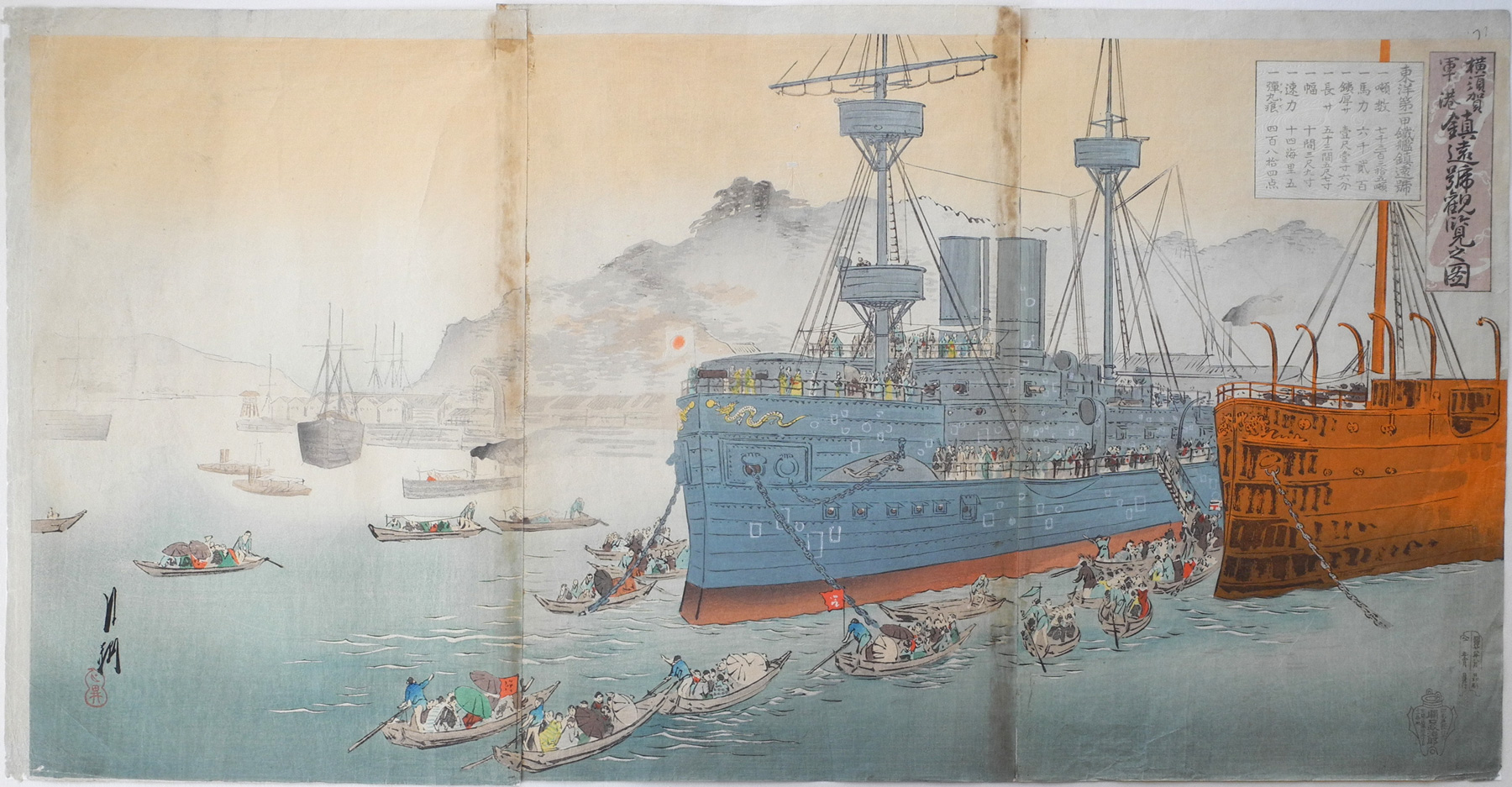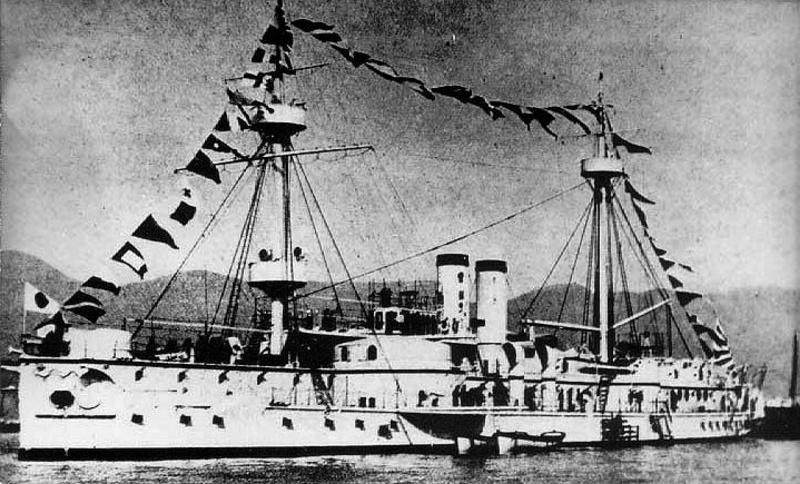About This Print
Source: Information on the Chinen taken from wikipedia http://en.wikipedia.org/wiki/Chinese_turret_ship_ZhenyuanIn addition to this print Gekkō created a similar print (see below), depicting the captured Chinese battleship Chinen 鎮遠 in its new home port at the Yokosuka navy yard in Kanagawa Prefecture. The Chinen (Chinese: Zhenyuan 鎮遠; also romanized as Chen Yuen) was a German-built Chinese Beiyang Fleet turret ship of the 19th century. Built with 14-inch (360 mm) thick armor and modern Krupp guns, they were superior to any in the Imperial Japanese Navy at the time.
undated photo of Chinen |
She fought in the Sino-Japanese War (1894-1895) at the Battle of the Yalu River, which took place on 17 September 1894. Captured by the Japanese after the Weihaiwei siege on February 17, 1895, she was rebuilt in 1896/7 and served throughout the Russo-Japanese War (1904-1905) as a second-line battleship, under the name Chin'en - the Japanese rendition of the ship's original Chinese name. She was scrapped in 1914.
Viewing the Chinen
Source: Impressions of the Front: Woodcuts of the Sino-Japanese War, Shunpei Okamoto, Philadelphia Museum of Art, 1983, p. 44."After the surrender at Weihaiwei, the Chenyuen [Chinen] was taken to Yokosuka, where the public was invited to see the 7,300-ton ironclad. One war reporter, Nagamatsu of the Jiji Shimpo wrote:
| Since the beginning of the war, all over Japan, men and women, young and old, have spoken of the Chinese ironclads Chenyuen and Tingyuen. Now that the Chenyuen has been captured and brought to Japan, it is understandable that everyone should want to see it. Before the public opening, Japanese naval officers constantly had to entertain visitors aboard. On August 5, the ship was opened to the public. Throngs from Tokyo and Yokohama, and even some who must travel overnight, are suddenly crowding Yokosuka. Already on the fourth, there was not a vacant room in town. Earlier, in Nagasake, so many people visited the Chenyuen that the waterline sank one foot. Perhaps it will be worse in Yokosuka; the train between Shinbashi in downtown Tokyo and Yokosuka has been packed." |
Naval Battle of Wei Hai Wei
Source: The Sino-Japanese War of 1894-1895: Perceptions, Power and Primacy, S. C. M. Paine, Cambridge University Press, 2003, p. 98-100.The land and sea attack on Wei Hai Wei (Waihaiwei) by Japanese forces lasted twenty eight days from January 20 through February 16, 1895. It is considered the last major battle of the Sino-Japanese War. The deciding sea battle began with heavy shelling on February 3 and by February 9 the Chinese fleet of 20 warships was reduced to four vessels and a few gunboats by a much larger Japanese force. Within a few days Chinese Admiral Ting had surrendered to Japanese Admiral Ito.
The Surrender of Admiral Ting
Source: The Sino-Japanese War of 1894-1895: Perceptions, Power and Primacy, S. C. M. Paine, Cambridge University Press, 2003, p. 107.
To His Excellency Ito, Commander–in-Chief of the squadron.
"…having fought resolutely, having had my ships sunk and my men decimated, I am minded to give up the contest, and to ask for cessation of hostilities in order to save the lives of my people. I will surrender to Japan the ships of war now in Wei-Hai-Wei harbour…"
(Signed) Ting Zhuchang, Tituh of the Peiyang Fleet
(Dated) 18th day of the 1st month of the 22nd year of Kawag-su (February 12, 1895)
"After thanking Admiral Ito for saving the lives of his men, he wrote a telegram to Viceroy Li-Hung-Chang, withdrew to his quarters and committed suicide…"
Other Prints in Collection Depicting the Battle of Weihaiwei
Chinese Admiral Ding Ruchang about to Commit Suicide after Surrendering to Japanese Forces
Picture of the occupation of the Hodai Fort, at Wei-Hai-Wei by our 2nd Army
Picture of the violent battle in the snow in the Toshu Province near Wei-Hai-Wei
Picture of the Attack on the Battery at Weihaiwai
For a comic view of the Chinen see the print Spoiled Chinese Battleship Chinen from the series Comical Art Exhibit of the Sino-Japanese War by Kobayashi Kiyochika (1847-1915).
latest revision:
To His Excellency Ito, Commander–in-Chief of the squadron.
"…having fought resolutely, having had my ships sunk and my men decimated, I am minded to give up the contest, and to ask for cessation of hostilities in order to save the lives of my people. I will surrender to Japan the ships of war now in Wei-Hai-Wei harbour…"
(Signed) Ting Zhuchang, Tituh of the Peiyang Fleet
(Dated) 18th day of the 1st month of the 22nd year of Kawag-su (February 12, 1895)
The Suicide of Admiral Ting
Source: The Sino-Japanese War of 1894-1895: Perceptions, Power and Primacy, S. C. M. Paine, Cambridge University Press, 2003, p. 100."After thanking Admiral Ito for saving the lives of his men, he wrote a telegram to Viceroy Li-Hung-Chang, withdrew to his quarters and committed suicide…"
Other Prints in Collection Depicting the Battle of Weihaiwei
Chinese Admiral Ding Ruchang about to Commit Suicide after Surrendering to Japanese ForcesPicture of the occupation of the Hodai Fort, at Wei-Hai-Wei by our 2nd Army
Picture of the violent battle in the snow in the Toshu Province near Wei-Hai-Wei
Picture of the Attack on the Battery at Weihaiwai
For a comic view of the Chinen see the print Spoiled Chinese Battleship Chinen from the series Comical Art Exhibit of the Sino-Japanese War by Kobayashi Kiyochika (1847-1915).
Print Details
| IHL Catalog | #529 |
| Title or Description | Illustration of the Viewing of the Captured Chinese Warship Chinen at Yokosuka Naval Port 横須賀軍港鎮遠号観覧之図 Yokosuka gankō Chinengō kanran no zu |
| Artist | Ogata Gekkō (1859-1920) |
| Signature | Gekkō |
| Seal | unread artist's gourd-shaped seal below signature |
| Publication Date | 1895 (Meiji 28) |
| Publisher | Sekiguchi Masajirō |
| Impression | excellent |
| Colors | good |
| Condition | fair - panels are glued together with non-water soluble adhesive which has stained the paper along the seems; light soiling throughout; left margin has been reinforced from rear along with lower-right corner; full margins |
| Genre | ukiyo-e - senso-e (Sino-Japanese War) |
| Miscellaneous | |
| Format | vertical oban triptych |
| H x W Paper | 14 5/8 x 28 5/8 in. (37.1 x 72.7 cm) |
| Literature | |
| Collections This Print | Princeton University Art Museum 2008-138 a-c |
3/1/3/2020




